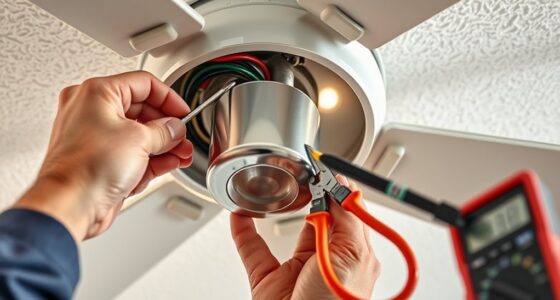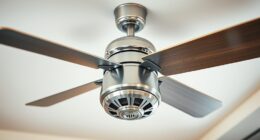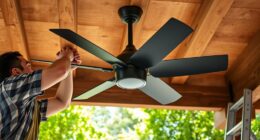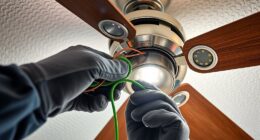In high humidity, fan blades can weaken, warp, and sag, causing wobbling and noise. To tackle this, regularly inspect your blades for signs of damage or imbalance. Tighten loose screws, gently straighten warped blades, and remove dust or corrosion with proper cleaners. Applying rust-resistant coatings and controlling indoor humidity can also help. Keep these tips in mind, and you’ll discover more ways to maintain your fan’s performance in humid conditions.
Key Takeaways
- Regularly inspect blades for warping, corrosion, and imbalance to detect sagging early.
- Tighten or replace loose or damaged blades, ensuring secure attachment to the hub.
- Clean blades thoroughly and apply rust-resistant coatings to prevent moisture-related deterioration.
- Control indoor humidity with dehumidifiers and proper ventilation to reduce moisture buildup.
- Lubricate motor parts and adjust blade alignment to maintain balance and prevent sagging.
Understanding How Humidity Affects Fan Blades
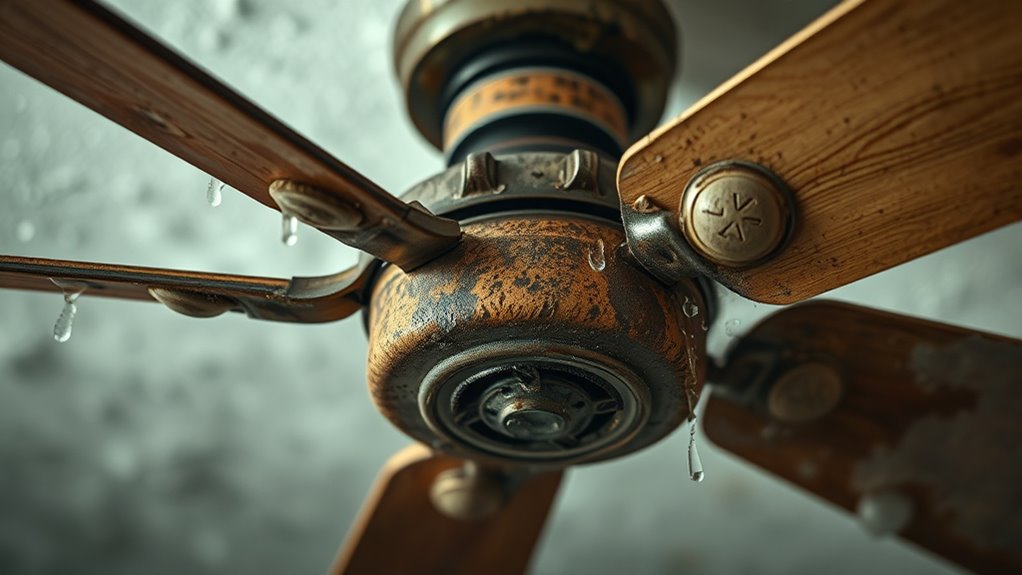
Humidity can have a significant impact on fan blades, especially in environments with high moisture levels. When exposed to excess moisture, the blades absorb it, leading to moisture absorption that weakens their structure over time. This absorption accelerates corrosion effects, causing the metal or other materials to deteriorate faster. As the blades absorb humidity, their surfaces become more prone to rust and corrosion, which can compromise their balance and overall integrity. The continuous exposure to moisture creates a cycle where corrosion effects worsen, making the blades more susceptible to sagging and damage. Additionally, high humidity can increase the likelihood of material degradation, further diminishing the lifespan of the fan blades. Recognizing the role of corrosion processes in material deterioration can help in implementing effective protective measures. Environmental factors such as humidity levels can significantly influence the rate of deterioration, emphasizing the importance of proper maintenance and protective measures. Understanding this process helps you recognize how high humidity environments can accelerate wear and tear on your fan blades, emphasizing the importance of proper maintenance and protective measures.
Signs That Your Fan Blades Are Sagging
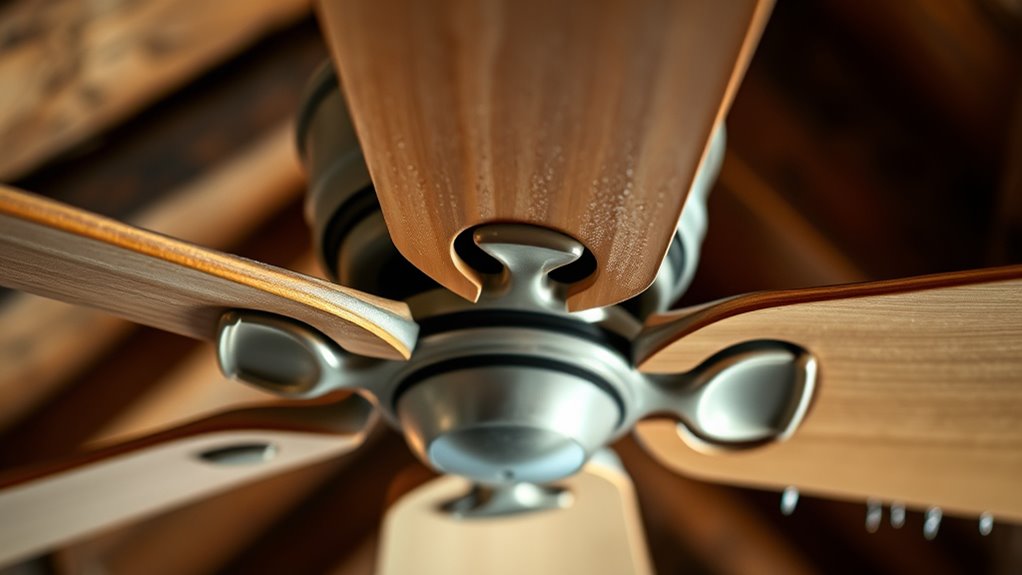
If you notice uneven or wobbling movement when your fan is on, it could be a sign that the blades are sagging. Look closely for these warning signs:
- Blade warping — the blades may bend or twist, disrupting smooth operation and causing wobbling.
- Color fading — faded or discolored blades indicate prolonged exposure to high humidity, weakening the material.
- Unusual noises — squeaking or rattling sounds suggest imbalance from sagging blades.
These signs not only compromise your fan’s efficiency but also hint that the blades are losing their structural integrity. Addressing these issues early can prevent further damage and restore proper airflow. Keep an eye out for these visual and auditory clues to catch sagging blades before they worsen.
Gathering Supplies for Blade Adjustment
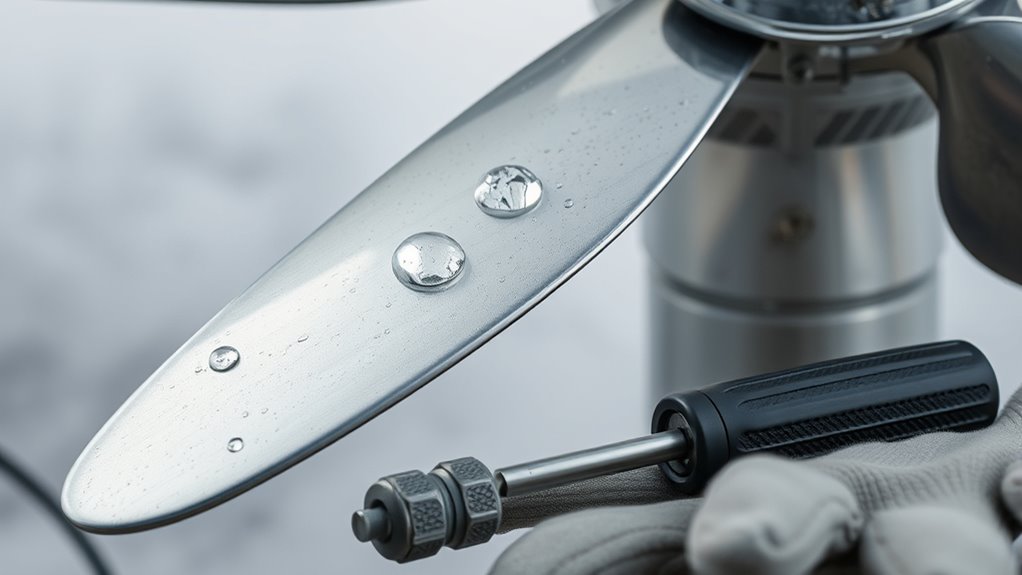
Before you start adjusting your fan blades, gather all the necessary tools and supplies to guarantee a smooth process. You’ll need a ladder or sturdy step stool to reach the blades safely. Have a screwdriver on hand—typically a Phillips or flathead—to loosen or tighten mounting screws. A level is essential for proper blade alignment, ensuring the blades are even and balanced. Keep some cleaning supplies ready, like a cloth and mild cleaner, to remove dust or corrosion that might interfere with adjustments. If your fan uses specific mounting techniques, check the manufacturer’s instructions beforehand. Having everything prepared minimizes interruptions and ensures you can focus on correctly aligning the blades, preventing unnecessary adjustments later. Proper supplies make the process quicker, safer, and more effective. Additionally, understanding the fan blade balancing process can help you achieve a quieter, more efficient fan operation. Preparing the correct tools in advance can also help you avoid costly repairs caused by improper adjustments.
Step-by-Step Guide to Fixing Sagging Fan Blades
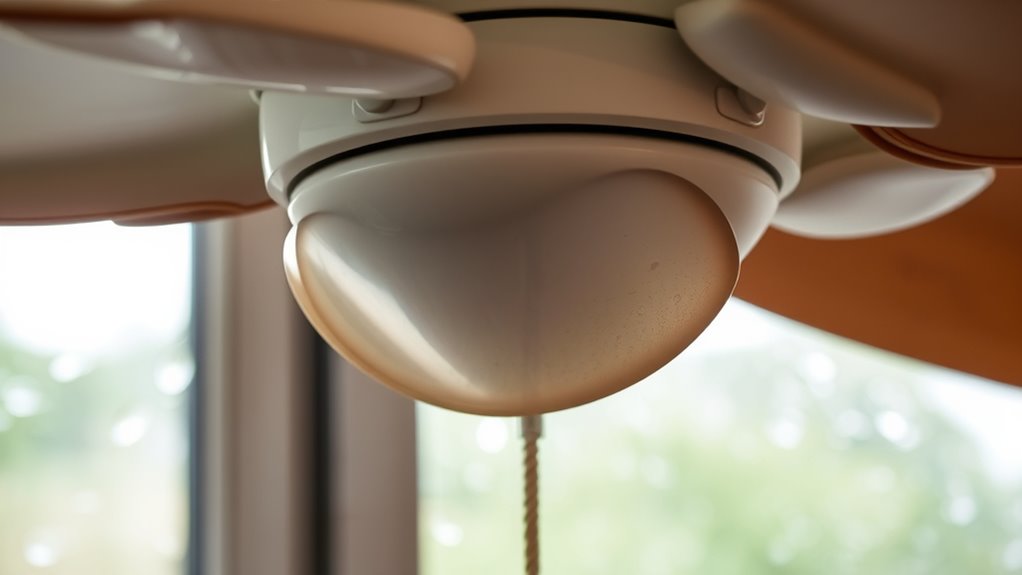
Start by turning off the fan and unplugging it to guarantee safety. Next, carefully inspect the fan blades for sagging or unevenness. To fix this, follow these steps:
Always turn off and unplug the fan before inspecting blades for sagging or unevenness.
- Adjust the fan blade balance by gently bending the warped blades back into shape or replacing severely damaged ones. Proper fan blade alignment is crucial for safe operation and to prevent further damage.
- Ensure proper motor lubrication by applying a few drops of lubricant to the motor’s moving parts, reducing friction that can cause blade sagging.
- Secure all blades tightly to the fan hub, making sure they’re evenly spaced and firmly attached to prevent wobbling.
- Regularly maintain your fan by checking these elements helps maintain ideal fan performance and prevents further sagging. Proper fan blade balance and motor lubrication are essential for a safe, long-lasting fan.
Preventative Measures to Protect Your Fan From Humidity Damage

High humidity can accelerate wear and cause fan blades to sag or corrode over time. To protect your fan, ensure proper fan blade balance; unbalanced blades increase stress and wear. Regularly check for wobbling and adjust blade alignment as needed. Additionally, maintaining adequate motor lubrication reduces friction and prevents moisture buildup that can lead to rust. Use a lubricant recommended by the manufacturer and apply it periodically, especially in humid environments. Keep the fan area well-ventilated and dry, minimizing excess moisture exposure. Installing a dehumidifier or using moisture-absorbing materials around the fan can also help. Proper maintenance and tuning of your fan system can further prevent issues caused by high humidity. Furthermore, understanding the impact of humidity on mechanical parts can guide you in selecting appropriate protective measures. Being aware of automation in business can help you implement efficient solutions for humidity control. These preventative measures help preserve the integrity of your fan, extend its lifespan, and reduce the risk of damage caused by high humidity.
When to Consider Replacing Your Fan Blades or Unit
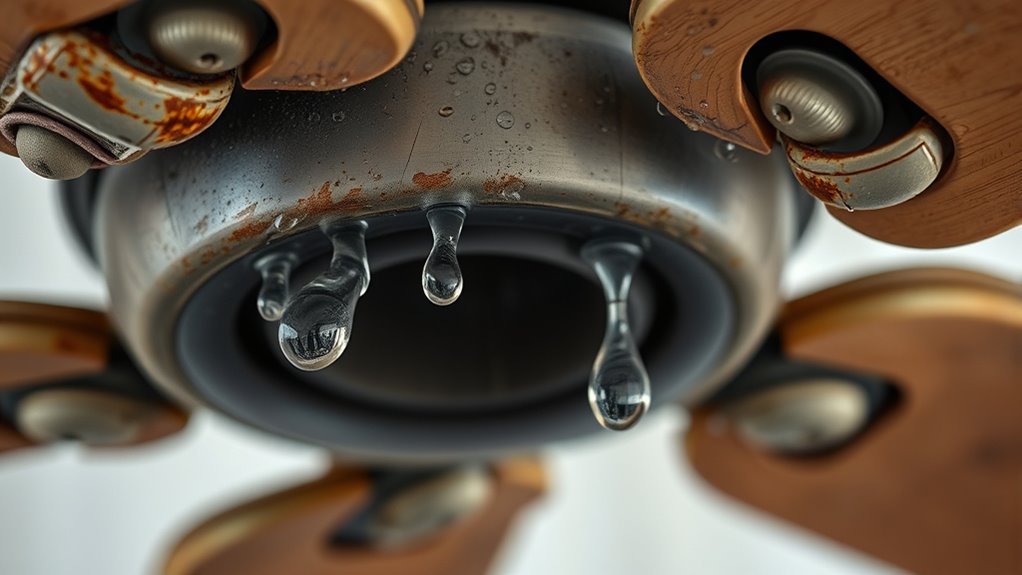
If you notice visible damage to your fan blades or signs of excessive wear, it’s time to contemplate replacement. Age also plays a role; older units may no longer operate efficiently or safely. When damage or age outweigh the cost of repairs, replacing the blades or the entire unit becomes the best choice. Considering maintenance and upgrades can help ensure your system remains reliable and efficient over time. Regular inspections can also identify potential issues before they lead to costly failures, especially in high humidity conditions. Proper air purifier maintenance and timely filter replacements further support optimal performance and longevity of your unit.
Visible Blade Damage
Visible damage to your fan blades, such as cracks, chips, or warping, is a clear sign that it’s time to contemplate replacing them or the entire unit. If you notice blade corrosion or paint peeling, these issues worsen over time and can compromise safety and efficiency. Ignoring these signs can lead to sudden blade failure, risking injury or damage. Consider replacing your blades or unit if:
- You see cracks or chips that weaken the blade’s structure.
- You notice extensive corrosion or paint peeling that exposes metal to moisture.
- The blades are warped or bent, causing wobbling and noise during operation.
- Persistent high humidity can accelerate blade deterioration, making timely replacement even more crucial. Additionally, high humidity environments can speed up material fatigue, further increasing the importance of early intervention. Regular inspections can help detect early signs of fabric degrading, ensuring prompt action before significant damage occurs.
Addressing these issues promptly helps prevent further damage and maintains peak airflow, especially in high humidity environments. Don’t wait until a minor flaw becomes a major hazard.
Age and Wear
Over time, even well-maintained fan blades experience wear that can diminish their performance and safety. As your fan ages, the materials—such as metal, plastic, or composite—may weaken or degrade, especially if they lack good corrosion resistance. Humidity accelerates this process, causing corrosion or deterioration that leads to sagging or imbalance. If you notice persistent wobbling, unusual noises, or decreased airflow despite cleaning and upkeep, it’s probably time to think about replacing the blades or the entire unit. Fan blade materials play a key role in longevity; blades with better corrosion resistance last longer in humid environments. Regular inspections can help you catch signs of age and wear early, ensuring safe, efficient operation before problems worsen. Additionally, using appropriate maintenance techniques can help extend the lifespan of your fan blades and prevent premature sagging. Implementing proper corrosion protection measures can also significantly improve durability in high humidity conditions.
Tips for Maintaining Optimal Fan Performance in Damp Environments
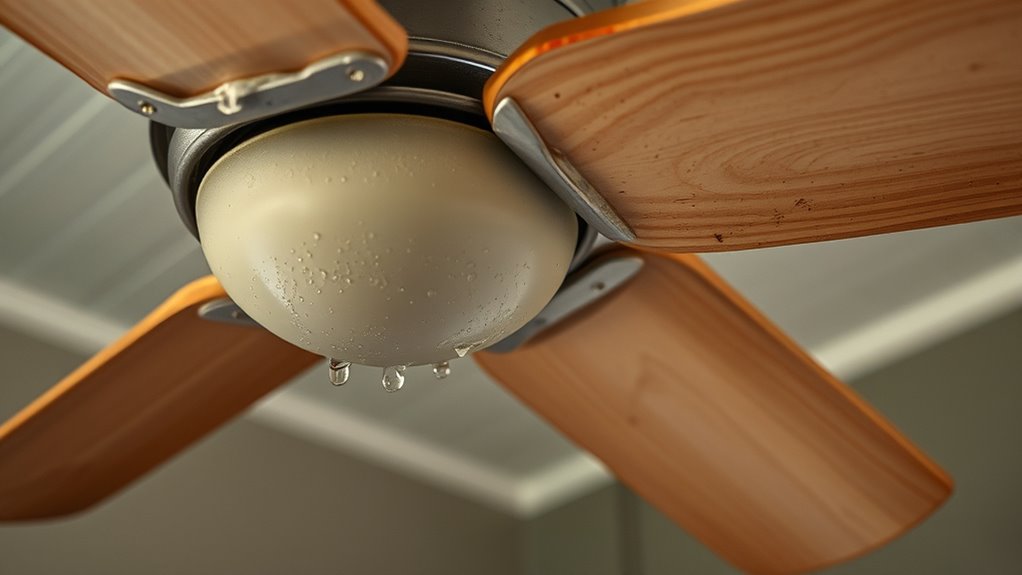
To keep your fan performing well in damp environments, start by inspecting the blades regularly for signs of corrosion or sagging. Applying rust-resistant coatings can help protect metal parts, extending their lifespan. Additionally, controlling humidity levels around your fan minimizes moisture buildup and prevents damage. Using an air purifier equipped with HEPA filters can also improve indoor air quality and reduce excess moisture that contributes to corrosion. Maintaining proper ventilation is essential to prevent moisture accumulation and safeguard your fan components over time.
Regular Blade Inspections
Regular blade inspections are essential for maintaining ideal fan performance in damp environments, where high humidity can accelerate corrosion and wear. During inspections, focus on signs of rust, warping, or imbalance. To keep your fan running smoothly:
- Check fan blade balancing to prevent vibrations and uneven wear.
- Inspect for corrosion and clean blades thoroughly to avoid buildup.
- Ensure motor lubrication is adequate to reduce friction and overheating.
Addressing these factors promptly helps prevent sagging and maintains efficiency. Regularly balancing the blades minimizes stress on the motor, extending its lifespan. Proper lubrication ensures smooth operation, reducing the chance of rust-induced failure. Consistent inspections keep you ahead of potential issues caused by damp conditions, safeguarding your investment and guaranteeing peak performance.
Use of Rust-Resistant Coatings
In damp environments, applying rust-resistant coatings is one of the most effective ways to protect fan blades from corrosion. Proper coating application creates a barrier that prevents moisture from reaching the metal surface, enhancing rust prevention. Before applying, ensure the blades are clean and dry. Choose a high-quality, weather-resistant coating suitable for humid conditions. Use a brush, roller, or spray to apply an even coat, covering all surfaces thoroughly. Multiple thin layers are better than one thick coat. Regular reapplication may be necessary as coatings wear over time. The table below highlights key steps for effective coating application:
| Step | Action | Purpose |
|---|---|---|
| Surface Prep | Clean and dry blades | Maximize adhesion |
| Primer | Apply rust-inhibiting primer | Improve rust prevention |
| Coating Layers | Apply multiple thin coats | Ensure even coverage |
| Curing | Let coats dry completely | Strengthen protection |
| Maintenance | Reapply periodically | Maintain rust resistance |
Proper Humidity Control
Maintaining ideal fan performance in damp environments requires effective humidity control strategies. High humidity levels can cause metal parts to corrode, increase the risk of sagging blades, and impair fan lubrication. To protect your equipment, consider these tips:
- Monitor and adjust humidity levels regularly to stay within optimal ranges, preventing excess moisture buildup.
- Use dehumidifiers or ventilation systems to reduce moisture in the air, safeguarding fan components from corrosion.
- Ensure proper fan lubrication by applying rust-resistant lubricants suited for high humidity, which keeps blades and moving parts functioning smoothly.
Frequently Asked Questions
How Often Should I Inspect Fan Blades in Humid Climates?
You should inspect your fan blades at least once every three months to guarantee proper fan blade maintenance. Humidity effects can cause blades to weaken or sag over time, leading to imbalance and noise. In humid climates, more frequent checks—around once a month—are recommended to catch any issues early. Regular inspections help prevent damage and keep your fan operating efficiently, especially when high humidity accelerates wear and tear.
Can Using Dehumidifiers Help Prevent Blade Sagging?
Think of your fan blades as the wings of a bird, soaring smoothly only when air circulation and moisture control are balanced. Using dehumidifiers acts like a gentle breeze around your bird, reducing moisture that causes sagging. By controlling humidity, you protect your fan’s integrity, ensuring consistent air circulation. So, yes, dehumidifiers can help prevent blade sagging, keeping your fan flying high and functioning perfectly even in humid conditions.
Are There Specific Materials Better Suited for High-Humidity Environments?
In high-humidity environments, you’ll want fan blades made from corrosion-resistant materials like stainless steel or certain plastics, which withstand moisture better. Applying humidity-resistant coatings can also shield blades from rust and deterioration. These choices help maintain your fan’s performance and longevity, preventing sagging or damage caused by moisture. Selecting the right materials and coatings guarantees your fan stays efficient and in good condition despite the humid conditions.
What Safety Precautions Should I Take When Adjusting Fan Blades?
Did you know that nearly 10% of electrical accidents happen during home repairs? When adjusting fan blades, always prioritize electrical safety by turning off the power at the circuit breaker. Use proper tools like insulated screwdrivers and gloves to prevent shocks. Never touch electrical components with wet hands or in damp conditions, especially in high humidity. Taking these precautions keeps you safe while ensuring your fan operates smoothly.
How Do I Choose the Best Fan for Damp Indoor Spaces?
When choosing the best fan for damp indoor spaces, prioritize models designed for moisture resistance to guarantee durability. Look for fans with easy fan maintenance features and rust-resistant blades, which make blade replacement simple when needed. Consider fans with sealed motors to prevent humidity damage. This way, you keep your space comfortable while minimizing maintenance and extending the lifespan of your fan.
Conclusion
By understanding how humidity can weaken your fan blades, you’re better equipped to spot issues early and take action. Think of your fan as a loyal companion whose health depends on your care—neglect it, and it may falter when you need it most. With proper maintenance and preventive steps, you can keep your fan spinning smoothly through every storm and sunshine, turning a simple appliance into a steadfast ally against the dampness that seeks to undermine your comfort.




